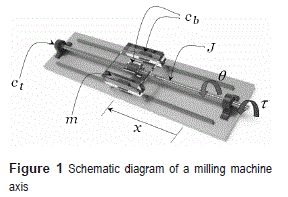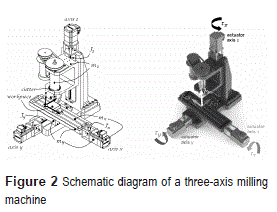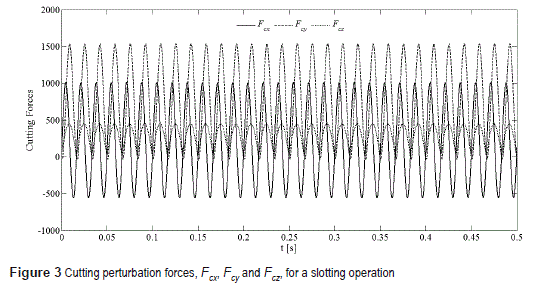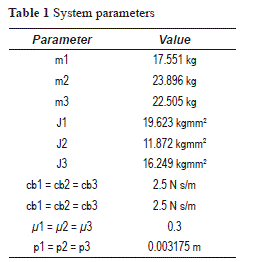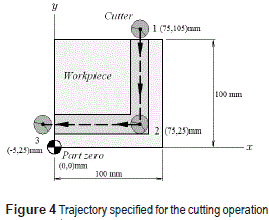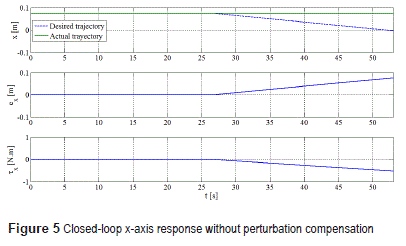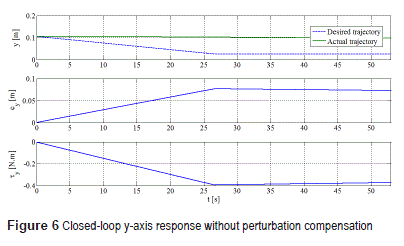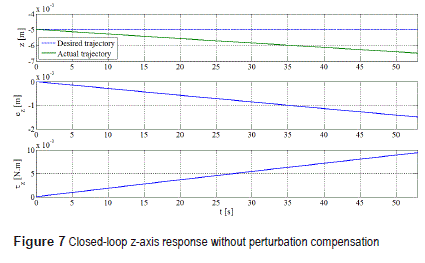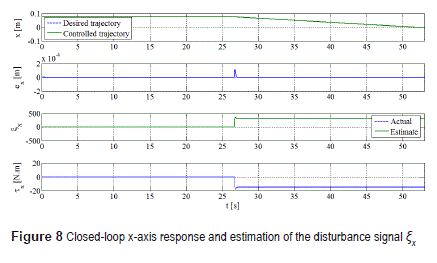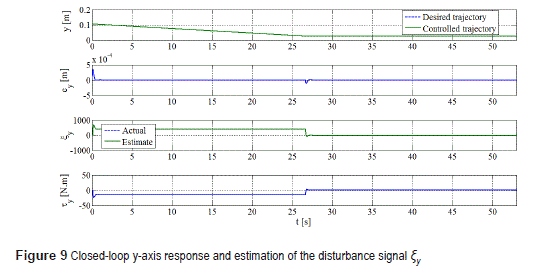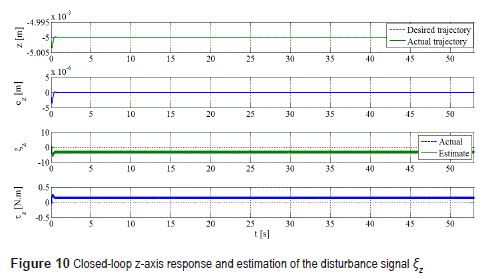Services on Demand
Journal
Article
Indicators
-
 Cited by SciELO
Cited by SciELO -
 Access statistics
Access statistics
Related links
-
 Cited by Google
Cited by Google -
 Similars in
SciELO
Similars in
SciELO -
 Similars in Google
Similars in Google
Share
Revista Facultad de Ingeniería Universidad de Antioquia
Print version ISSN 0120-6230
Rev.fac.ing.univ. Antioquia no.69 Medellín Oct./Dec. 2013
ARTÍCULO ORIGINAL
Active Perturbation Rejection in Motion Control of Milling Machine Tools
Rechazo activo de perturbaciones en el control de movimiento de máquinas-herramienta fresadoras
Francisco Beltrán Carbajal1*, Esteban Chávez Conde2, Antonio Favela Contrera3, René F. Vázquez Bautista4
1Universidad Autónoma Metropolitana. Unidad Azcapotzalco. Departamento de Energía. CP. 02200. México D.F., México.
2Universidad del Papaloapan. Campus Loma Bonita. Departamento de Mecatrónica. CP. 68400. Loma Bonita, Oaxaca, México.
3ITESM. Campus Monterrey. Departamento de Mecatrónica y Automatización. CP. 64849. Monterrey, Nuevo León, México.
4Universidad Veracruzana. FIEC. CP. 93390. Poza Rica, Veracruz, México.
*Autor de correspondencia: teléfono: + 52 + 55 + 53189066, fax + 52 + 55 + 53189070, correo electrónico: fbeltran.git@gmail.com (F. Beltrán)
(Recibido el 25 de febrero del 2013. Aceptado el 11 de octubre de 2013)
Abstract
This article deals with the robust control problem of the motion axes of milling machine tools subjected to perturbation forces induced by the metal machining process. A position output feedback control scheme is proposed for robust rejection of unknown cutting and friction perturbation forces and robust tracking tasks of motion trajectories planned for a three-axis milling machine tool. The Coulomb friction, viscous damping and cutting forces are considered as terms of an unknown time-varying disturbance input signal affecting the dynamics of the motion axes of the milling machine. In the motion control design, the perturbation signal is modeled locally by a fourth degree Taylor time-polynomial family. Then, a state observer is designed to estimate the disturbance and velocity signals required for implementation of the proposed motion controllers. Simulation results are included to show the robust performance of the proposed motion control scheme and the fast and effective estimation of the perturbation and velocity signals.
Keywords: Milling machine tool, motion control, motion planning, perturbation rejection
Resumen
En este artículo se aborda el problema de control robusto de los ejes de movimiento de máquinas- herramienta fresadoras sujetos a fuerzas de perturbación que se inducen durante el proceso de maquinado del metal. Se propone un esquema de control por retroalimentación de la salida de posición para el rechazo robusto de fuerzas de perturbación de fricción y de corte desconocidas, y para tareas de seguimiento robusto de trayectorias de movimiento planificadas para una máquina-herramienta fresadora de tres ejes. Se considera la fricción de Coulomb, el amortiguamiento viscoso y las fuerzas de corte como términos de una señal de entrada de perturbación variable en el tiempo desconocida, la cual afecta la dinámica de los ejes de movimiento de la máquina fresadora. En el diseño del control de movimiento, se modela la señal de perturbación mediante una familia de polinomios en el tiempo de Taylor de cuarto grado. Entonces, se diseña un observador de estado para estimar las señales de velocidad y perturbación que se requieren para la implementación del controlador de movimiento propuesto. Se incluye resultados en simulación para mostrar el desempeño robusto del esquema de control de movimiento propuesto y la estimación efectiva y rápida de las señales de perturbación y velocidad.
Palabras clave: Máquina-herramienta fresadora, control de movimiento, planificación de movimiento, rechazo de perturbaciones
Introduction
Robust and efficient control of automatic metal- cutting machine tools has become a very important and challenging research topic because of the modern manufacturing systems demand high levels of production and quality of manufactured products. Therefore, the motion control algorithms for these mechatronic machines must guaranty real-time, fast and accurate tracking of the specified machining trajectories, minimizing the positioning and contouring errors. In addition, the designed controllers should be simple and low cost for their practical implementation. Thus, the reduction of the sensor number is an important criterion that must be taken into account in the design process of any motion control scheme for automatic-metal machining machines.
On the other hand, the machining process dynamics is very complex, involving nonlinear friction and cutting forces, structural nonlinearities, parametric uncertainty, undesirable vibrations, and others nonlinear effects (see [1-8] and references therein). Hence the motion control schemes should be robust with respect to those perturbation dynamics and their design will be commonly based on simplified mathematical models instead of exact mathematical models. In fact, there exist several developments of controllers for machine tools, which are based on Lyapunov methods, classical control, neural networks, adaptive force control, nonlinear state observer-based control, variable-gain control, fuzzy logic control and H® control, as well as other control design methodologies (see [9-15] and references therein).
In this paper, it is proposed a position output feedback control scheme with on-line compensation of disturbance signals for robust and accurate tracking tasks of reference trajectories specified for the motion axes of a three-axis milling machine tool using position output measurements only. The presented motion control approach can be extended to n-axis milling machine as well as to other types of metal-machining machine tools such as turning and drilling machines.
The control design methodology used in this study differs basically from others in that the robust motion control problem of machine-tool axes is suitable combined with the estimation of unknown bounded disturbance signals affecting directly the input-output system dynamics by employing Taylor time-polynomial models to locally describe those signals. The main advantage of this approach is the synthesis of robust linear control and estimation algorithms quite simple and feasible to be implemented using commercial control technologies. The estimation of disturbance and velocity signals is based on the design methodology of robust state observers with respect to un-modeled perturbation input signals of polynomial type described by Sira-Ramirez et al in [16]. The resulting state observer is called the Generalized Proportional Integral (GPI) observer because its design approach is the dual counterpart of the so-called GPI controller [17, 18].
In the design process of the proposed motion control scheme, a simplified linear mathematical model, similar to those used in [9-12] for control design purposes, describing the dynamics of the motion axes subjected to unknown bounded disturbance signals is considered. Into these disturbance signals are included the cutting and friction forces and possibly un-modeled dynamics and parametric uncertainties. A family of fourth degree Taylor time-polynomials is proposed to model locally the disturbance signal. Then, the extended disturbance signal-plant mathematical model is used to design a Luenberger observer to asymptotically estimate the disturbance and velocity signals required for implementation of the proposed controllers. Simulation results are provided to show the efficient and robust tracking performance of the presented motion control scheme as well as the fast and effective estimation of the perturbation and velocity signals.
Mathematical model of milling machine motion axes
Dynamic model
Consider the schematic diagrams of a motion axis of a milling machine shown in figures 1 and 2. The generalized coordinate x is the linear displacement of the cart. In addition, θ is the angular displacement of the power transmission screw, m is the mass of the cart, J is the mass moment of inertia of the ball screw, cb, and ct are the equivalent viscous damping coefficients of the cart and screw bearings, respectively, and τ is the control input torque.
The mathematical model that describes the dynamic behaviour of the X, Y and Z motion axes of the three-axis milling machine shown in figure 2 is then given by the set of uncoupled perturbed ordinary differential equations (1) and (2).
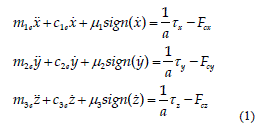
where

In the above, ''sign'' denotes the signum function, J1 , J2 and J3 are the mass moments of inertia of each screw of the X, Y, and Z axes, respectively, m1, m2 and m3 are the masses of each cart, which are displaced by the screws, cbi and cti, i = 1, 2, 3, are the equivalent viscous damping coefficients of the nut and guideways bearings, and of the support bearings of the screws of each axis, respectively. Here, a = p/2π is the proportionality constant of the angular-linear displacement, x = aθ, and p is the pitch of the transmission screw μ1 , μ2, and μ3 are the Coulomb friction forces for each axis of the machine, Fcx, Fcy and Fcz are the cutting forces induced by the machining process in the X, Y, and Z directions, g is the gravity acceleration constant. In addition, τx , τy and τz denote the control input torques applied to the X, Y, and Z motion axes, respectively.
Defining as state variables to the displacements and velocities of the carts of each axis as follows x1 =x, x2, =  , y1 = y, y2 =
, y1 = y, y2 =  , z1 = z, z2 =
, z1 = z, z2 =  one obtains the state space description (3).
one obtains the state space description (3).
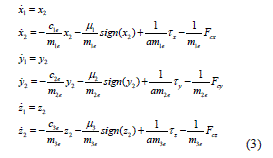
It is easy to verify that the system (3) is completely controllable from the control variables, τx , τy and τz, and observable from the output variables, x1 , y1 and z1.
Quasi-static mathematical model of cutting forces
In this study, the quasi-static mathematical model (4) for prediction of the cutting forces for slotting and side milling operations proposed by Kline [6-8] is used to only evaluate the robustness of the proposed motion control scheme.
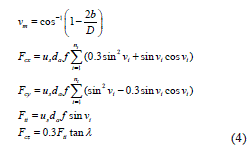
where us is the power required to machine a unit volume of the work material, da is the cutting depth in Z axis direction, f is the feed per tooth, nt is the number of teeth on the cutter in contact with the workpiece, D is the diameter of the milling cutter, λ is the angle of the cutting edges, b is the depth of the side cut, vi is the tool rotation angle, (v0, vm) is the angular range of a cutting edge cuts.
Figure 3 illustrates the significant cutting forces for a slotting operation on soft steel (us = 0.5 kW/ cm3/min) resulted by applying the mechanistic model (4). These forces will be considered as terms of the unknown disturbance signals affecting the dynamics of the machine motion axes. For this milling operation, a vertical cutter with two edges was employed, with λ = 45°, D = 10 mm, da = 0.005 m, f = 0.001 m and spindle speed N = 1800 rpm, nt = 1 and b = 10 mm.
Motion control with disturbance compensation
In the design of the motion controllers for the X, Y and Z axes, it is considered the simplified mathematical model (5) subjected to the disturbance signals ξy and ξz given by (6), (7) and (8), respectively.

where 

Under the assumption that estimates of the disturbance and velocities signals are available to be used in the synthesis of control laws, we propose the output feedback controllers (9) with compensation of the perturbation signals for robust tracking tasks of reference trajectories specified for the motion axes of the milling machine.
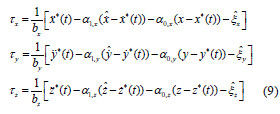
where x*(t), y*(t) and z*(t) are the desired position reference trajectories for the carts of the X, Y and Z axes, respectively. Here,  x,
x,  y,
y,  z,
z,  ,
,  , and
, and  denote estimates of the disturbance and velocity signals.
denote estimates of the disturbance and velocity signals.
The use of the controllers (9) yield the set of uncoupled homogenous linear differential equations (10) for the closed-loop dynamics of the tracking errors, ex = x-x*(t), ey = y-y*(t) and ez =z-z*(t).

The characteristic polynomials of the closed-loop dynamics are then given by (11).

Therefore, selecting the design parameters α0,i, α0,i, i = x, y, z, so that the characteristic polynomials (11) are Hurwitz (stable) polynomials, the robust and asymptotic tracking of the reference trajectories is guaranteed.
In this work the Hurwitz polynomials (12) are proposed to compute the gains of the controllers.

where ωc,i > 0 and ξc,i> 0 are the natural frequencies, and viscous damping ratios, respectively, for the desired closed-loop dynamics of the tracking errors.
Since the controllers (9) require information of the disturbance signals ξx, ξy and ξz, and the velocities of the carts of the milling machine, in this paper is proposed the application of the design methodology of robust observers with respect to polynomial type perturbation input signals proposed by Sira-Ramirez et al. in [16] for on-line estimation of the disturbance and velocity signals. The proposed disturbance observer is called Generalized Proportional Integral (GPI) observer, because its design approach is the dual counterpart of the so-called GPI controllers [17], and whose robust performance, with respect to unknown perturbation inputs, nonlinear and linear un-modeled dynamics and parametric uncertainties, have been evaluated extensively through experiments for trajectory tracking tasks on a vibrating mechanical system by Sira-Ramírez, Beltrán-Carbajal and Blanco-Ortega [18].
Design of the Luenberger state observer
In the design process ofthe observer, the perturbation input signals are locally described by the family of fourth degree Taylor polynomials (13).

where all the coefficients pJ,i are completely unknown.
An extended state-space model for the perturbed dynamics of the motion axes of the milling machine is thus given by (14).
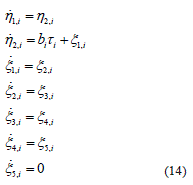
wehre 
The disturbance and velocity signals can then be estimated by the Luenberger state observer (15).
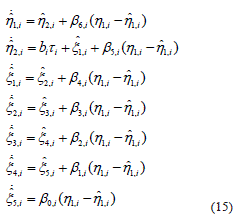
The dynamics of the estimation errors,  , k=1, 2…, 5, i = x, y, z, are then given by (16).
, k=1, 2…, 5, i = x, y, z, are then given by (16).
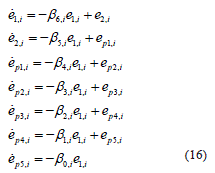
From this expression, one can obtain the characteristic polynomials (17) of the dynamics of the estimation errors.

which are completely independent of any coefficients pj,i of the Taylor polynomial expansions of the disturbance signals ξi(t).
In this study, the design parameters of the state observer (15) are choosing so that the characteristic polynomials of the dynamics of the observation errors (17) are Hurwitz polynomials described by (18).

where po,i, ζo,i, ωo,i, >0, i = x, y, z.
Simulation results
In order to verify the dynamic behavior of the motion control scheme of the axes of a milling machine and the estimation of the disturbance signals proposed in this paper, some numerical simulations were carried out using the system parameters described in table 1.
Figure 4 shows the cutting trajectories specified for cutting motion in the x-y plane. The first desired movement is a straight line starting at the point 1 and ending at the point 2. Next, the cutter moves from point 2 toward point 3 in straight line also. The cutting depth in z axis direction is a constant value and the modulus of the x path from point 2 to point 3 is 0.08 m (80 mm), which is the same for the modulus of the y path from point 1 to point 2 (80 mm). This path of 80 mm is specified to be performed into a time of 26.667 s.
According to the parameters used in the quasi-static mathematical model of cutting forces (depth of cut of 5 mm, feed per cutter tooth of 0.05 mm, number of teeth on the cutter of 2, and spindle speed of 1800 revolutions per minute), one gets the feed rate of 3 mm/s and the time required to mill the path of 80 mm as 26.667 s.
The equations of the straight lines are described as follows. From point 1 to point 2 by equations (19):
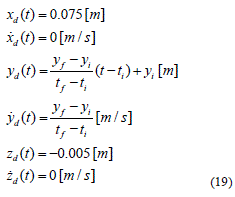
with initial (i) and final (f) conditions given by (20).

From point 2 to point 3 by equations (21):
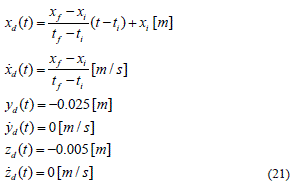
with initial (i) and final (f) conditions given by (22).

Figures 5-7 present the performance ofthe control scheme (9) without employing the feedforward terms of the perturbation signals. This is, the values of the estimates of those signals were set to be zero,  , in the control implementation. Here, it is evident the inefficient performance on the tracking of the cutting trajectories, with large tracking errors. Of course, that performance is unacceptable for machining tasks of products.
, in the control implementation. Here, it is evident the inefficient performance on the tracking of the cutting trajectories, with large tracking errors. Of course, that performance is unacceptable for machining tasks of products.
On the other hand, figures 8-10 depict the robust and efficient tracking performance of the proposed control approach rejecting disturbances directly affecting the dynamics of the motion axes of the milling machine. In addition, one can observe the fast and effective estimation of the disturbance signals. The control gains were selected to get Hurwitz (stable) polynomials according to the equation (8), with ωc,i= 12 rad/s and ζc,i= 0.7071, i = x, y, z. The gains of the disturbance observer were set to be ωo,i = po,i =700 rad/s and ζo,i = 0.7071.
Conclusions
In this paper we have proposed a PD control scheme based on rejection of disturbances for robust and efficient tracking tasks of reference trajectories specified for the movements of the axes of a three-axis milling machine tool. The cutting and friction forces generated during the machining process of the workpiece were considered as unknown bounded perturbation signals affecting the motion axes dynamics. Into these perturbation signals could be included other disturbances as parametric uncertainties, vibrations, unmodeled dynamics and so on. Since the deigned controllers requires information of these signals, a real-time estimation scheme of perturbation signals based on Taylor polynomial models has been applied. Simulations results show the robust and efficient performance of the proposed disturbance observer-control approach, as well as the fast and effective estimation of the disturbances signals.
References
1. H. Ding, S. Chen, K. Cheng. ''Two-Dimensional Vibration-Assisted Micro End Milling: Cutting Force Modelling and Machining Process Dynamics.'' Proc. IMechE Part B: J. Engineering Manufacture. Vol. 224. 2010. pp. 1775-1783. [ Links ]
2. M. Kaymakci, Z. Kilic, Y. Altintas. ''Unified Cutting Force Model for Turning, Boring, Drilling and Milling Operations.'' International Journal of Machine Tools & Manufacture. Vol. 54-55. 2012. pp. 34-45. [ Links ]
3. X. Jin, Y. Altintas. ''Prediction of Micro-Milling Forces with Finite Element Method.'' Journal of Materials Processing Technology. Vol. 212. 2012. pp. 542-552. [ Links ]
4. T. Schmitz, K. Smith. ''Machining Dynamics - Frequency Response to Improved Productivity.'' Ed. Springer. 2009. pp. 99-170. [ Links ]
5. K. Ehmann, S. Kapoor, R. Devor, I. Lazoglu. ''Machining Process Modeling: A Review.'' Journal of Manufacturing Science and Engineering. Vol. 119. 1997. pp. 655-663. [ Links ]
6. R. DeVor, W. Kline, W. Zdeblick. A Mechanistic Model for the Force System in End Milling with Application to Machining Airframe Structures. Proceedings of the 8th North American Conference on Metalworking Research. Rolla, USA. 1980. pp. 297-303. [ Links ]
7. W. Kline, R. DeVor, J. Lindberg. ''The Prediction of Cutting Forces in End Milling with Application to Cornering Cuts.'' International Journal of Machine Tool Design and Research. Vol. 22. 1982. pp. 7-22. [ Links ]
8. D. Stephenson, J. Agapiou. Metal Cutting Theory and Practice. 2nd ed. Ed.Taylor & Francis. Boca Raton, USA. 2006. pp. 459-502. [ Links ]
9. J. Lee, W. Dixon, J. Ziegert. ''Adaptive Nonlinear Contour Coupling Control for a Machine Tool System.'' The International Journal of Advanced Manufacturing Technology. Vol. 61. 2012. pp. 1057-1065. [ Links ]
10. J. Fortgang, W. Singhose, J. Márquez, J. Perez. ''Command Shaping Control for Micro-milling Operations.'' International Journal of Control, Automation, and Systems. Vol. 9. 2011. pp. 1136-1145. [ Links ]
11. K. Byung, R. Seung, P. Jong. ''Development of a 3-axis Desktop Milling Machine and a CNC System Using Advanced Modem Control Algorithms.'' International Journal of Precision Engineering and Manufacturing. Vol. 11. 2012. pp. 39-47. [ Links ]
12. B. Yao, M. Al, M. Tomizuka. ''High-Performance Robust Motion Control of Machine Tools: An Adaptive Robust Control Approach and Comparative Experiments.'' IEEE/ASME Transactions on Mechatronics. Vol. 2. 1997. pp. 63-76. [ Links ]
13. Y. Koren. ''Control of Machine Tools.'' Journal of Manufacturing Science and Engineering. Vol. 119. 1997. pp. 749-755. [ Links ]
14. T. Zheng, Y. Syh, H. Pau. The Integrated Linear and Nonlinear Motion Control Design for Precise CNC Machine Tools. Proceedings of the 2004 IEEE International Conference on Control Applications. Taipei, Taiwan. 2004. pp. 724-729. [ Links ]
15. J. Zheng, M. Zhang, K. Meng. Modeling and Design Servo System of CNC Machine Tools. Proceedings of the 2006 IEEE International Conference on Mechatronics and Automation. Luoyang, China. 2006. pp. 1964-1969. [ Links ]
16. H. Sira, V. Feliu, F. Beltran, A. Blanco. Sigma- Delta Modulation Sliding Mode Observers for Linear Systems Subject to Locally Unstable Inputs. Proceedings of the 16th Mediterranean Conference on Control and Automation. Ajaccio, France. 2008. pp. 344-349. [ Links ]
17. M. Fliess, R. Márquez, E. Delaleau, H. Sira. ''Correcteurs Proportionnels-Intégraux Generalisées.'' ESAIM, Control, Optimization and Calculus of Variations. Vol. 7. 2002. pp. 23-41. [ Links ]
18. E. Chávez, F. Beltrán, A. Valderrábano, A. Favela. ''Active Vibration Control of Vehicle Suspension Systems Using Sliding Modes, Differential Flatness and Generalized Proportional-Integral Control.'' Rev. Fac. Ing. Univ. Antioquia. No. 61. 2011. pp. 104-113. [ Links ]













